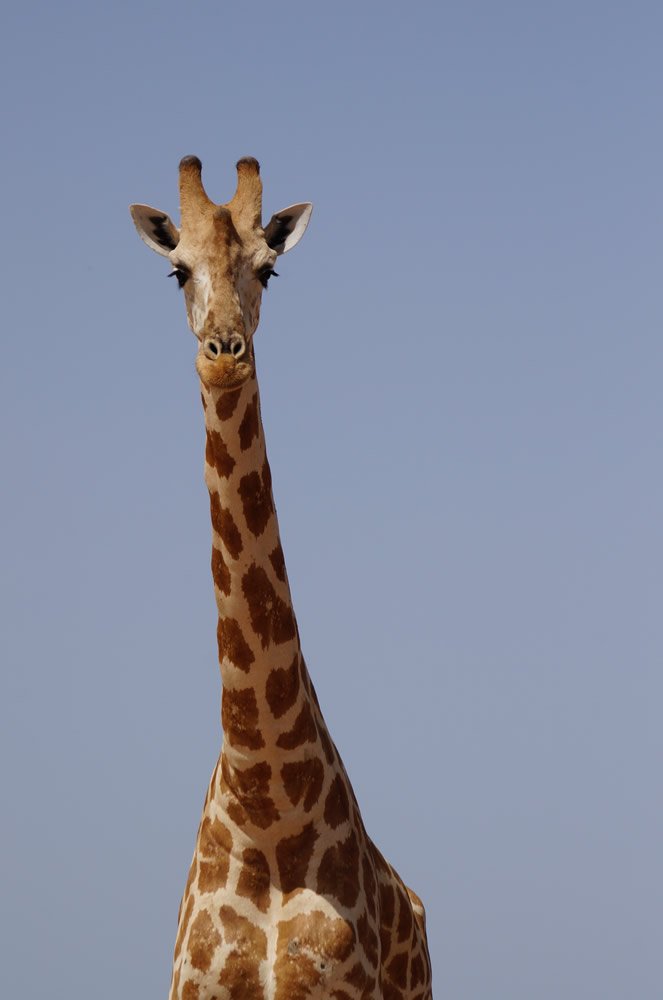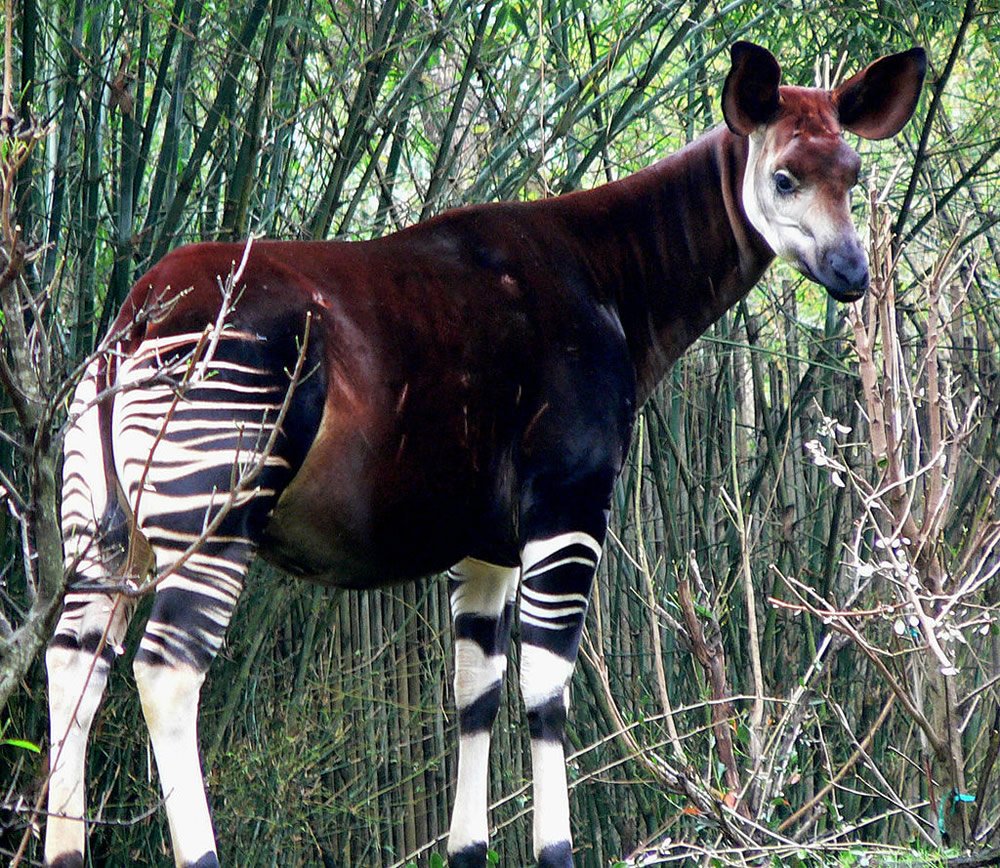
Genes Hold the Giraffe’s Head Up High
News to Know
Abstract
The giraffe’s genome explains its long neck but does not support an evolutionary tall tale.
News Sources
Parading across many an African skyline is the iconic giraffe with its long neck, a sturdy extension that lets it munch on treetop foliage. Despite the extraordinary length of its neck, the giraffe has only seven vertebrae in its neck, the same number as other mammals. The giraffe’s cervical vertebrae articulate with ball-and-socket joints, making the giraffe’s neck extraordinarily flexible. In the giraffe each cervical vertebra is supersized—10–11 inches long in an adult. The whole bony chain of huge cervical vertebrae is anchored by extra-thick ligaments to bony extensions on the thoracic vertebrae near the shoulders. That ligamentous support and the fact that the front legs are taller than the rear enable a giraffe to effortlessly balance an 8-foot tall, 500-pound neck and hold its head high.
The giraffe’s comparably supersized heart generates a blood pressure 2.5 times that of humans to push blood all the way up to the animal’s brain. Yet when the giraffe dips its neck to drink or graze on groundcover, the sudden onrush of high-pressure blood is diverted into a marvelous network of vessels to keep it from flooding the giraffe’s head. Meanwhile, tight skin around the legs and thickened vasculature throughout the giraffe’s body prevents its high blood pressure from damaging structures below the neck. Everything about the giraffe is designed to work together to support its high-flying head.
Genetic Underpinning of a Grand Design
Geneticists have recently sequenced the giraffe genome and that of its short cousin, the okapi, and compared them to other mammals. Having identified genes that differ dramatically in giraffes, scientists believe they’ve located the genetic blueprint responsible for many of the giraffe’s unique features.

Despite the extraordinary length of its neck, the giraffe has only seven vertebrae in its neck, the same number as other mammals. Photo courtesy of Taylor Pool.
Evolutionary scientists believe these differences, the genetic underpinning of what makes a giraffe a giraffe, are the result of random mutations accumulated over millions of years. They believe the giraffe evolved from a common ancestor shared with cattle by way of these mutations. Commenting on the study, David Haussler of the Genomics Institute at the University of California, Santa Cruz, says, “This is one more wonderful demonstration of the power of comparative genomics to connect the evolution of animal species on this planet to molecular events that we know must underpin the extraordinary diversity of life on this planet.”1
But did random molecular events generate the diversity of life on earth? Have scientists now discovered the evolutionary path giraffes followed in their supposed divergence from a common ancestry with cattle? Is a giraffe just an evolutionary modification of a primitive cow? Let’s have a look.
The researchers found that, compared to other mammals, the giraffe has multiple distinctive differences in 70 of its genes. Two-thirds of these are regulatory genes—genes that govern the expression of other genes. These regulatory genes govern skeletal, cardiovascular, and nervous system development as well as physiologic functions.2 “All of these genes in the giraffe—we have them ourselves,” says Douglas Cavener, who led the study. “What made giraffes unique is just to tinker with them a bit and alter them in subtle ways.”3
Regulatory genes often influence multiple developing systems. Some of the distinctive giraffe genes regulate metabolism, skeletal growth, and cardiovascular function.4 Therefore, the researchers believe they have discovered how the giraffe simultaneously evolved its long neck and the cardiovascular system to support it. Lead author of the genomic study, Morris Agaba, says, “There are many theories about how the giraffe’s neck lengthened but it does seem that the development of the cardiovascular system evolved in parallel with the development of the skeletal system.”5
The regulatory gene that impressed the researchers most was FGFRL1. This gene encodes a protein that regulates skeletal and cardiovascular development in humans. But the differences in FGFRL1 are not “subtle,” nor are they plausibly the result of random “tinkering.” The protein encoded by the giraffe’s FGFRL1 gene differs by seven amino acids from the version found in other mammals. Those seven differences are not random either: they are in a cluster in the portion of the protein that interacts with another regulatory protein (fibroblast growth factor, FGF).6 By its influence on FGF, FGFRL1 influences the size of the body segments, or somites,7 that form in the embryo as the raw material and scaffolding for more differentiated structures. At least it does in chick embryos, where things like this are most easily tested. Although the authors have not documented somite enlargement in the giraffe embryo, they suspect these regulatory genes in the early embryo8 may lay the groundwork for the disproportionate growth of the giraffe’s cervical vertebrae.9
Other regulatory genes must work together with FGFRL1 to restrict the supersizing of body parts to particular regions—like the cervical spine and the legs. Three of the giraffe-distinctive genes have this sort of function in embryos: HOXB3, CDX4, and NOTO. Altogether there are nine giraffe genes whose proteins, compared to other mammals, exhibit a large number of unusual amino acid differences at strategically important locations.10
How did their genetic differences come to be?
At this time, researchers do not know the specific anatomic significance of any of these differences, but they expect to test many of them one at a time by altering the genomes of laboratory mouse embryos to see what abnormalities can be created. Yet if they do create a long-necked mouse, as Cavener joked, would that demonstrate that the giraffe evolved from a common cattle ancestor by accumulating mutation upon mutation to grow its supersized neck and great heart and all the other anatomical distinctions that make a giraffe work? Not at all. They would simply reveal the functional significance of each genetic difference, not how those differences could have arisen simultaneously and randomly in the unobserved past to produce a whole new sort of animal.
The interpretation of the giraffe’s genome in comparison to the okapi’s and to other mammals rests on this: How did their genetic differences come to be?
Giraffe and Okapi and Their Extinct Cousins

This okapi is a member of the giraffidae family. The okapi and giraffe are the only living members of the giraffe kind, but the fossil record reveals there were once other varieties with necks shorter than today’s giraffes but taller than the okapis. Photo from Raul654, via Wikimedia Commons.
Let’s first consider the comparison of the giraffe to the okapi. These are the only two living members of the giraffidae family, but they don’t look much alike. Nevertheless, they are varieties of the same kind of animal, a point on which creationists and evolutionists agree. Therefore it is no surprise that 19.4% of the protein-coding genes in the okapi and the giraffe are identical.11 The okapi and giraffe genomes share much more in common than either does with cattle.12 And okapi share some but not all of the dramatic genetic distinctives of the giraffe.13
What about extinct members of the giraffe family? How long were the necks of the giraffes that got off the Ark? We cannot be dogmatic about that, but the fossil record does contain a variety of giraffids with necks shorter than the modern giraffe but longer than the okapi.14 The fossil record also preserves some branched forms of the horns adorning giraffe heads.15 Too bad we cannot sequence the genomes of those extinct giraffids! If we could we would be able to catalogue the sorts of differences between these varieties of the same created kind of animal. Differences between varieties of the same created kind are not the result of upward evolution. They result from the sorting and shuffling and sometimes the loss of genetic information. Mutations may lead to variations within a created kind, but they do not produce new genetic information of the type necessary for one kind of animal to evolve into a different kind of animal.
Giraffes and Other Mammals
But what about the differences and similarities between giraffes and other mammals? Like cattle, giraffes are ruminants. In fact they are the world’s largest living ruminants. Ruminating mammals are able to use microbial gut flora in their compartmentalized stomachs to ferment plant material that would otherwise be indigestible. Then they regurgitate and chew the food again, or “chew the cud.” But does this common characteristic, among others, mean the giraffe diverged from a common ancestor shared with all cattle by growing a longer neck and a stronger heart? Not at all. Whether we are comparing easily visible characteristics—like cud chewing and long necks—or the genes that blueprint those traits, similarities are not proof of common ancestry but rather common designs are exactly what we would expect from a wise, common Designer, the Creator God of the Bible. Likewise, genetic differences between different created kinds of animals cannot be accounted for through the tinkering and tweaking of random chance processes.
The giraffe and okapi genomes are both dramatically different from that of cattle. How did those genetic differences come to be? Did they arise through the accumulation of mutations from a ruminating, hoofed common ancestor shared with cattle? No. First of all, there is no biological evidence showing that one kind of animal can acquire the genetic information to become a completely different kind of animal. (Besides, where did the information in the genes come from in the first place? Random processes do not create information or the machinery to interpret it.) Secondly, mutations do not create new genetic information of the type necessary for molecules-to-man evolution; they only alter or destroy it. Finally, given the many traits of the giraffe that must coexist for the animal to survive, getting all those genetic bells to chime at the same time would add a whole additional level of irreducible complexity to the process. Discovery of regulatory genes that govern multiple systems does not solve the problem of irreducible complexity. All those specific differences must be in place, in molecules and systems that must all work together, before the giraffe could conceivably evolve.
Discovery of regulatory genes that govern multiple systems does not solve the problem of irreducible complexity.
The conclusions in the study comparing the giraffe and okapi genomes to other mammals are couched in evolutionary terms. For instance, genetic differences between different kinds of animals are referred to as “distinctive changes” and “substitutions,” implying their assumed shared evolutionary history. However, nothing about these dramatic genetic differences between giraffes and other kinds of mammals indicates they were the result of accumulating mutations—“distinctive changes” and “substitutions”—over millions of years. That idea is purely an evolutionary assumption. In fact, the Nature News & Comment article describing the research says as much: “This study identifies genes associated with the giraffe’s adaptations, but does not prove their role in the animal’s evolution.”16
Designed to Vary, Not to Evolve
The fossil record demonstrates that shorter varieties of giraffes were around at the time of the global Flood. Since giraffes have split hooves and chew the cud, they would have been considered “clean” animals (Genesis 7:2), so we expect there would have been up to seven pairs of the giraffe kind on board the Ark with Noah. All the giraffes and okapis alive today descended from those giraffids that got off the Ark. So if giraffes, or giraffids, were perhaps not always as tall as they are today, how did they get to be so tall?
The giraffe is a marvel of design, showcasing numerous designs that must work together. This study has discovered the probable genetic underpinnings of many of the giraffe’s unique traits. It is inconceivable that the massive number of differences needed to build a really big giraffe could have come about through random mutations. However, the fact that God apparently designed the regulatory genes in these animals to affect multiple systems in a coordinated fashion—so that changes in the skeletal and the cardiovascular systems work together—gives us some insight into the way dramatic variations within a created kind can be produced. The original created giraffe kind might not have stood as tall as today’s giraffe—we don’t know. But we do know that the tall, majestic giraffe of today declares the glory of its Creator.
Further Reading
- Reimagining Ark Animals
- From Bacteria to Giraffes: Adapting Reality to Fantasy
- Truth from Telegraph, the World’s Newest Zonkey
- How Are New Genes Made?
For More Information: Get Answers
Remember, if you see a news story that might merit some attention, let us know about it! (Note: if the story originates from the Associated Press, FOX News, MSNBC, the New York Times, or another major national media outlet, we will most likely have already heard about it.) And thanks to all of our readers who have submitted great news tips to us. If you didn’t catch all the latest News to Know, why not take a look to see what you’ve missed?
(Please note that links will take you directly to the source. Answers in Genesis is not responsible for content on the websites to which we refer. For more information, please see our Privacy Policy.)
Footnotes
- Bethany Augliere, “Genome Reveals Why Giraffes Have Long Necks,” Nature, May 17, 2016, http://www.nature.com/news/genome-reveals-why-giraffes-have-long-necks-1.19931.
- Morris Agaba et al., “Giraffe Genome Sequence Reveals Clues to Its Unique Morphology and Physiology,” Nature Communications 7 (May 2016): 6, doi:10.1038/ncomms11519.
- Augliere, “Genome Reveals Why Giraffes Have Long Necks.”
- Agaba et al., “Giraffe Genome Sequence Reveals Clues To Its Unique Morphology and Physiology.”
- “Genes Tell How the Giraffe Got Its Long Neck,” Reuters, May 17, 2016, http://mobile.reuters.com/article/idUSKCN0Y81TT.
- Agaba et al., “Giraffe Genome Sequence Reveals Clues To Its Unique Morphology and Physiology,” 3.
- Ibid., 6.
- Ibid., 3.
- Of note, the giraffe’s cervical vertebrae—and to a lesser extent its first thoracic vertebra also—do much of their disproportionate growing after birth, a point not addressed in this study. Otherwise, because giraffes are born with the unbent head immediately following the extended forelegs, newborn giraffes with a very long neck might have difficulty emerging from the birth canal, according to authors of a 2010 study on fetal and post-natal giraffe vertebral growth. Neonatal giraffes are doubtless following the growth program dictated by their genetic blueprint, though the mechanism that causes the elongation of the cervical vertebrae after birth is as yet unknown. The answer will likely be found in those giraffe genetic distinctives uncovered in this genomic analysis, but it must involve factors that affect more than just the embryonic development of the giraffe. (The post-natal growth of the giraffe’s cervical vertebrae is discussed in Sybrand J. van Sittert et al., “From Fetus to Adult—An Allometric Analysis of the Giraffe Vertebral Column,” Journal of Experimental Zoology Part B: Molecular and Developmental Evolution [April 2010]: doi:10.1002/jez.b.21353.)
- Agaba et al., “Giraffe Genome Sequence Reveals Clues to Its Unique Morphology and Physiology,” 5.
- Ibid., 2.
- Ibid.
- Ibid., 6.
- Ibid.
- The Sivatherium, for instance, had a stocky body and branched horns, like a moose’s. The Bramatherium had horns resembling a four-pronged head-dress.
- Augliere, “Genome Reveals Why Giraffes Have Long Necks.”
Recommended Resources

Answers in Genesis is an apologetics ministry, dedicated to helping Christians defend their faith and proclaim the good news of Jesus Christ.
- Customer Service 800.778.3390
- © 2024 Answers in Genesis



